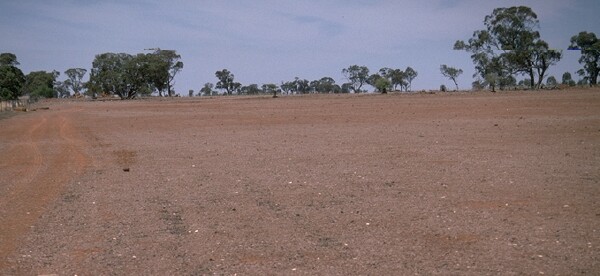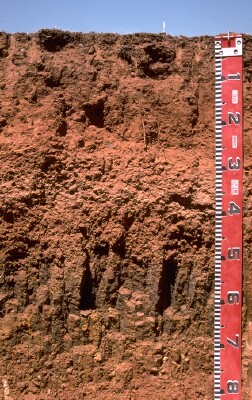LP37
| Group: Bridgewater Farm Advance | Australian Soil Classification: Ferric, Subnatric, Brown SODOSOL |
| Northcote Factual Key: Dy 3.43 | Great Soil Group: solodic soil |
| General Landscape Description: Lower slope of a low basalt rise. Original vegetation included Grey Box (Eucalyptus microcarpa) and Buloke (Casuarina luehmanni). | |
 LP37 Landscape |
Soil Profile Morphology
Surface Soil
| A11 | 0-10 cm | Dark reddish brown (5YR3/4); very fine sandy clay loam; weak coarse blocky structure; strong consistence dry; pH 5.8; clear change to: |  LP37 Profile |
| A12 | 10-25 cm | Dark red (2.5YR3/6) (becoming lighter in colour with depth); fine sandy clay loam; massive; strong consistence dry; contains very few (<2%) ferruginous nodules; pH 6.8; clear boundary change to: | |
| A2 | 25-40 cm | Yellowish red (5YR5/6) conspicuously bleached (5YR7/4d); fine sandy clay loam; massive; strong consistence dry; contains many (40%) ferruginous nodules; pH 7.3; abrupt change to: | |
| Subsoil | |||
| B2 | 40-50 cm | Strong brown (7.5YR5/6); medium heavy clay; strong medium polyhedral structure; strong consistence dry; contains very few (<2%) ferruginous nodules; pH 7.4; abrupt boundary change to: | |
| B3 | 50-80 cm | Brown (10YR5/3) with brownish yellow and yellowish red mottles; medium heavy clay; very strong coarse prismatic structure; strong consistence dry; contains very few (<2%) manganiferous flecks and dark staining between peds; pH 8.2; clear change to: | |
| B4 | 80+ cm | Yellowish red (5YR5/6); light clay; strong coarse blocky; strong consistence dry; contains a few (2-10%) carbonate nodules and dark manganiferous flecks throughout; pH 8.9. | |
Key Profile Features
- Strong texture contrast between the surface (A) horizons and the clay (B) subsoil.
- Conspicuously bleached subsurface A2 horizon.
- Sodic subsoil.
Key Profile Characteristics
pH | Salinity Rating | |||
Surface (A1 horizon) | moderately acid | very low | non-sodic | water-stable no dispersion1 |
Subsoil (B21 horizon) | slightly alkaline | very low | sodic | slight2 |
Deeper subsoil (at 1 m) | strongly alkaline | very low | sodic | __ |
| 1 Moderate dispersion after remoulding. 2 Complete dispersion with remoulding | ||||
 |
Management Considerations:
Surface (A) Horizons
- The surface horizons are relatively deep which will promote a favourable rooting environment.
- Dispersion can occur after remoulding. This indicates that the surface soil may disperse when cultivated or overstocked in a moist condition. This would exacerbate the hardsetting condition and could promote surface sealing and thus reduce infiltration and plant emergence. Minimising tillage and increasing organic matter levels would assist in alleviating this problem. Raindrop damage may occur after cultivation. A surface cover of plants or stubble may be needed to protect the soil from such damage.
- The overall nutrient status is moderate and total nitrogen levels appear to be relatively high for the surface horizon. The nutrient status for the subsurface (i.e. A12 and A2 horizons) is, however, much reduced.
- Plant available water holding capacity appears relatively good for the surface horizons. The wilting point is reasonably high (ie. 16%) which means that plants will make relatively less use of light showers falling on dry soil compared to the other sites in the area.
Subsoil (B) Horizons
- The top of the subsoil is sodic and disperses slightly in water (also has a low calcium:magnesium ratio). This is likely to restrict root and water movement through the subsoil. The presence of a conspicuously bleached A2 horizon above the subsoil indicates that periodic waterlogging may occur.
Landholder comments:
- Wheat, oats, barley, lupins rotation (1t/ha.) Lupins not economically viable, trying lucerne.
- Paddock has not been cropped for a few years.
Notes
- Profile described by Mark Imhof, Paul Rampant and Sonia Thompson (15/2/95)


